H. Tittle (Prisoner of War Camp Bando, Japan, 1919)
Translated from the German and edited by Joseph R. Svinth
Copyright © 2000. All rights reserved.

H. Tittle (Prisoner of War Camp Bando, Japan, 1919)
Translated from the German and edited by Joseph R. Svinth
Copyright © 2000. All rights reserved.

In November 1914 Japanese, British, and Indian sailors, soldiers,
and airmen took the Chinese treaty port of Qingdao (Tsingtao) from the
Germans, and in the process, captured about 5,000 prisoners. While some
of the German and Austrian women and children were repatriated in mid-1915,
the Allies kept the military-age men in Japan until the winter of 1919-1920.
Thankfully, the Japanese prison camps of World War I were far more civilized places than the Japanese prison camps of World War II, and, in the words of the British-edited Japan Times (June 16, 1915):
The prisoners may be hired for work by any one; but none has yet tried, fearing that they may desert. At present the only work in which they are employed is the preparation of some parade grounds.
They are not even the officers allowed to live outside their quarters; as witness the family of Colonel Waldeck [sic he was actually a naval captain] have left for America as they could not live with him.
Their health is on the whole very good, although some cases of typhus and other epidemics have been reported. It is to their credit that they pay much attention to their health. At Tokushima, Shikoku, they are now and then taken to the sea for bathing as their quarters are quite close to the seashore.
The following is an edited translation of a German-language sumo text written by a man interned at Camp Bando, in Tokushima prefecture. While I know nothing about Herr Tittle except that he apparently read English, German, and Japanese with considerable facility, the print shop at the Prisoner-of-War Detention Camp Bando published the original text under the title Sumo, der japanische Ringkampf nach japanischen Quellen, around June-July 1919.
The original German text has 42 pages and about 12,500 words. Illustrations include 33 line drawings and five full-color woodblock prints. The book's cover is cardstock. The paper used to make individual pages is oban, that is, rice paper sheets measuring about 15-1/2 by 10-1/2 inches that were first folded in half and then bound at the open end using string. The typesetting is woodblock, and features a hand-lettered Roman typeface.
This translation, however, measures about 7,500 words, and omits two major sections. The first is the historical overview placed at the beginning of the book and the second is the list of techniques placed near the end. The reason for not including the first section is that the history presented was based on since-discredited Japanese creation myths, and therefore of little interest except to philologists or antiquarians. Meanwhile, the second section is mostly pictures of throws, and for those who are interested, the original pages were scanned and included as illustrations.
Although the following translation is reasonably literal, several paragraphs near the end were reconfigured to provide the text with a stronger conclusion. Furthermore, punctuation was sometimes modified to make the text read better in English. (It was Mark Twain, after all, who observed that the German language is distinguished by the majestic mountain ranges of words it sends marching across the page.) Finally, while textual translations and footnotes are Tittle's, the endnotes are the editor's.
Japanese names are given in Western name order; diacritical marks
are omitted.
Robert W. Smith provided the original text used to make this
translation, and Lawrence Bickford, Richard Bowen, Earl Hartman, Richard
Hayes, Syd Hoare, Guy Power, and David Waterhouse provided suggestions
regarding the text and notes. All errors in translation or interpretation
are, however, solely the responsibility of the translator.
References used by Tittle included Karl Florenz, Japanische
Mythologie, Nihongi, "Zeitalter der götter" (Tokyo: Druck der
Hobunshu, 1901) and Emil Schiller, Shinto, die Volksreligion Japans
(Berlin-Schoneberg: Protestantischer Schriftenvertrieb, 1911).
References used in providing the annotations include:
 Wrestling officials. After an old Japanese woodcut.
Wrestling officials. After an old Japanese woodcut.
In Japan, one readily observes that wrestling (sumo) has
a religious background, and to this day there are wrestling events during
temple festivals. From the Japanese standpoint this is explained and permitted
because the sport represents a sacrifice to the first gods, the ones that
tradition says established it. The wrestling also reminds viewers of ancient
dance and religious exercises. (Surely in its oldest forms sumo must be
viewed as dance or burlesque or pantomime.) Finally, there is the possibility
that people transformed wrestling to advertise and enhance the popular
appeal of the temple festivals. Our earnest northern religious sensibilities
can comprehend such a festival, "with its commercial and show booths, with
horse races, wrestling, fireworks, illumination, with its tumultuous, cheerful
crowds of businesslike operations of the priests, and brightly colored
traditional costumes and music, as a combination of an annual trade fair
and a frugal church Christmas" (Schiller, Shinto).
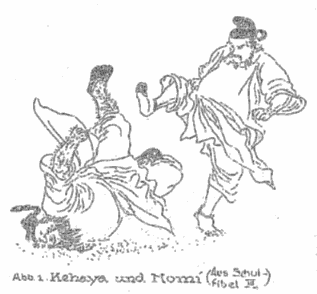 Kehaya
and Momi (two wrestlers of the legendary period)
Kehaya
and Momi (two wrestlers of the legendary period)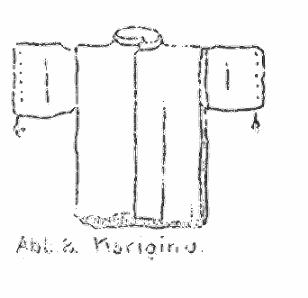 An
early royal costume
An
early royal costumeHow the priests cleverly turned wrestling to commercial advantage is shown in the following story: In 1624 a new temple was being built in Ueno, near Tokyo. After the buildings were completed the priests were financially embarrassed and did not know how they were going to get the wide court in front of the temple graded. Then someone had the sly idea of promoting a big wrestling match that thousands of people would attend, and in a short time the new temple's great plaza was trampled and at the same time the shrine received gifts and offerings.
Temple wrestling takes place in the middle of an open area near a shrine. The arena consists of sand bordered by straw-filled sacks. Especially near the big temples workmen occasionally built a raised arena with an awning over it for protection from the sun or rain. The public stood in circles around the ring.
A text called Kasuga Koki ("Ancient Chronicles of Kasuga") describes the ritual preceding such temple wrestling. First, one consecrates to the gods two tamakushi, which are a pair of holy sakaki trees festooned with white paper streamers (gohei). During the old days gohei were sacrificed fabrics or clothes; later people substituted paper strips. Next, two men dressed in long, "simple robes" [FN1] walk side by side into the arena, crying out ceremoniously to the gods. Four more men, the "next witnesses" (shisho) then follow them. The latter wear caps signifying rank [FN2] and a special costume. [FN3] Armed with bows and arrows and facing outward toward the gods, the shisho take up stations in the four corners of the arena. Next the referees enter; they are known here as wrestling judges (sumo-yakunin), and they too wear the previously described costumes.
Then the elders, or toshiyori, enter from the left and right. It used to be that the toshiyori dressed like wrestlers, that is to say in their birthday suits, except that they had long swords over their shoulders and paper ribbons tied in their high-bound hair. These days, however, the toshiyori appear dressed in the same festive costumes as the referees except that they carry war fans. Once in the ring, the toshiyori stick their swords in the sand. Then they take the paper out of their hair and throw it as a sacrifice to the gods. Here the religious process ends and the entire company now retreats and takes positions around the edge of the arena.
At this point the wrestlers enter the sento. Sento literally means "specially trained," but is better translated as "show place." As for the actual wrestling, it is called, strange to say, "Wrestling-dance entertainment" (sumo-bugaku).
During the past several years Japan's professional wrestlers have both increased their numbers and become better organized. The Tokyo and Osaka groups are the most important. From time immemorial these groups have been influential, but today they control the business end of the sport and set the standards for all other wrestlers. Therefore the press and public give them the greatest scrutiny. All other branches, guilds, and groups in the country are next to them meaningless. (While the wrestlers from Kyoto formerly played an important role, they fell completely into the background following the Meiji Restoration of 1868.) [EN2]
The organization of both the Tokyo and Osaka wrestling guilds will be described below; but first a few words about Japanese wrestlers need to be written. It takes hard work to become a good wrestler. Usually an old experienced wrestler who has retired from the arena takes a schoolboy aged fifteen to twenty years of age into his house. There the novice learns his profession. Because as a rule room, board, and training costs are borne by the master, the novice is expected to perform small services such as cleaning the room or following the master's bidding without complaint, and if from a wealthy family, doubtless to pay some tuition. [EN3]
The practical training is handled with great regularity and strictness, and that is today still the case. This practical training is divided into three parts. The first part involves exercises for building physical strength and flexibility. These include calisthenics and weight training. The second part involves a strict diet that on the one hand promotes muscle strength and on the other increases corpulence. (A thick paunch and mighty rolls of fat are essential prerequisites for a good wrestler. A skinny sumotori [wrestler] would never be popular with the public or, what is more important, gain the favor of the press; concave charms bring more money here than mighty biceps.) The third part involves associated exercises. These include special breathing drills, various ascetic practices, cold rubdowns, exercises in sitting still and in patience, hot baths, etc., such as are found in all kinds of Japanese sports. During training alcohol, tobacco, and sexual pleasure are more or less forbidden.
Each old wrestler maintains that his own special methods are the only correct ones for physical development and never reveals his underlying principles. Obviously not every apprentice proves successful and suitable. As a result, many eventually take up another profession.
Several years of persistent work and exercise pass before the young wrestler gets the opportunity to show his art during a small tournament. If he enjoys a little success, then his apprenticeship is ended and he is free to join a wrestling club. But that happens only occasionally.
Because the life of a provincial wrestler is not easy and the pay is trifling, it requires great perseverance to reach the heights. The social status of a small-time wrestler is in no way distinguished, and the novice's sights must always be fixed on becoming a member of the big-time in Osaka or Tokyo. To be successful the wrestler frankly must place himself on the road to glory and honor, to the good life and hopefully even riches.
Recently the development of young wrestlers, the ones jokingly called rikishi no tamago, or "wrestler eggs," has taken on a more business-like character. The old system of the individual development is disappearing and in its place the so-called heya, which is a kind of school for wrestlers, has appeared.
Most heya appear to manage a meager existence. Usually they are located inside a Japanese-style house with built-in pupils' living rooms and exercise halls (keikoba). Also the meeting and exercise places of the private and court wrestlers are called heya.
Tokyo possesses 48 heyas, all of which are operated and conducted by retired wrestlers. [EN4] Of these, the Dewanoumi heya is the biggest and best known. Famed for its model facilities and its strictly conducted system of exercises, it is reputed to have about sixty first-class wrestlers under its Tokyo canopy. Coming from there are, for example, Tochigiyama, Ryogoku, Tsushimanada, and others.
The Dewanoumi heya occupies a two-story building located in Tokyo's Honjo Aioi block, behind the police station of the same name. Its inside is simple and clean, and lodges 120 students. Facilities include a tearoom, library, and billiards room, plus of course all the appointments for sport and physical development right next to the many rooms for the students. [EN5]
As noted before, the important professional wrestlers are members of the Tokyo and Osaka camps. As a group, the wrestlers are considered maku-no-uchi, meaning "inside the curtain." Meanwhile, all others are maku-no-shita, meaning "outside the curtain."
Both major camps are divided into East and West. [EN6] At certain times of the year, usually in January, in May-June, and sometimes in September, the wrestlers of the two sides compete against one another.
Each major camp has about thirty first-class wrestlers. After these come maybe a hundred second-class men. Rank structure within the sides and camps follows the strictest precedence: [EN7]
2. Three champion wrestlers, or sanyaku ("The three officials"):
3. Ozeki.
b. Komusubi.
The highest rank is that of the yokozuna. The word yokozuna means "transverse cords," but because the yokozuna is actually the arm-thick white rope that this champion wears around his hips during the march into the ring, the term is better translated as "wrestling grand champion." The belt itself is supposed to be made from the holy streamers (shimenawa) that hang from the structure surrounding the sumo arena.
The next rank is that of ozeki. Ozeki means "big knot." In the old days ozeki had the highest reputation, and enjoyed free entrance to the castles of the court nobles. Nearly nothing is known about the origins of this name.
The famous ozekis from Tokyo were in the past year:
| January 1918: | East: | Asashio | West: | Tochigiyama |
| May 1918: | East: | Kyushuyama | West: | Chibagazaki |
| January 1919: | East: | Kyushuyama | West: | Asashio |
A highly acclaimed star of the May 1919 tournament was the ozeki Yakichi Tsushimanada, who had the unbelievable height of 1.91 meters.
Today the sekiwake ("junior champions") stand next to the ozeki, that is to the side of the ozeki, as a kind of adjutant. Their rank corresponds with an old rank known as hotewaki ("side men").
The next step is komusubi. The name is not explicable, as it literally means something like "small belt."
All other wrestlers are known as maegashira, a word meaning "before the heads". As the word is spoken as zento in Chinese, presumably it refers to the sento, which is the place where the actual wrestling takes place.
Promotions within a camp or side depend on the number of points that a wrestler acquires during the annual tournaments. Most of the upper steps are different. For example, sometimes there are two ozeki and one yokozuna in a camp. On the other hand, there is always just one komusubi on each side of the camp.
The wrestlers' attire is outwardly simple. Over their fundoshi (loincloths) they wear broad belts tightly buckled using strong, ready fasteners. Loose aprons made from little strings then dangle from the belts. During the preliminary parades, the wrestlers also wear decorated aprons called kesho-mawashi or simply mawashi.
These decorated skirts cost a small fortune. Typically they are made from expensive damask (thus the former name dansu, meaning damask). They are rich in gold threads and embedded with ideograms and pictures. Along the bottom edges hang ornamented tassels and fringes. [EN8] Therefore even the simplest skirt costs around ¥100. [EN9] Popular wrestlers receive these skirts from their patrons and other sports enthusiasts.
The wrestlers are distinguishable from other people both by their huge size and their tufts of bound hair. They say that the hair tufts are tied with papers covered with pious aphorisms and prayers. When a wrestler retires from the ring to private life, he has a prominent personality snip his topknot in a ceremonial manner. [EN10]
The personal incomes of most wrestlers are trifling. The camp pays the average wrestler ¥20-30 each season, and because a man only wrestles for his camp a couple times a year, these earnings do not support their lives. This forces the wrestlers to increase their incomes by making road trips (jungyo) through the provinces. It is the custom in Tokyo that a wrestler receives one yen for each trip plus 25 sen for each victory. He also receives an additional allowance of 50 sen for every four victories during a season. [EN11]
Of course wrestlers receive additional small subsidies from their guilds and popular wrestlers receive handsome gifts from patrons and sports fans. However, the great majority of them must slog through life parsimoniously. Therefore they have a simple life that is not judged by earnings, but by the favors of good company, especially of the female kind.
Just as in other countries, the Japanese public shows little interest in the art, but much interest in the artist's private life. So in addition to names, ranks, ages, and hometowns, one finds in the press detailed descriptions of wrestlers' camps, schools, sizes, weights, favorite foods, etc.
All wrestlers take pseudonyms by which they alone become known publicly. These ring names usually allude to their homelands or favorite scenes in nature. [EN12] To take some German examples, Drachenkago, Westmeer, and Isestrand are names of homelands while Pflaumental, Rotblattfluss, and Morgenflut are scenes in nature. A famous ozeki from Tokyo, for example, is called Onishiki. The ring name means "Big Brocade," but the man's family name is Hosogawa. [EN13]
 Onishiki,
during the introduction
Onishiki,
during the introduction
According to published accounts, the current crop of professional wrestlers is aged 28-35 years in aggregate; in East Tokyo in 1918 the oldest was 39, the youngest 23. Their height is by Japanese notions quite substantial, namely in aggregate about 1.8 meters. This demonstrates the Japanese can achieve increased physical dimensions in accordance with their lifestyle.
As in European wrestling, weight plays an important role in sumo. In East Tokyo it happened that the heaviest wrestler weight 37 kan or 139 kilograms while the smallest weighted 24 kan, or 90 kilograms.
As for which hometown the wrestlers came from, one may honestly say that every district in the Empire is represented in the camps. Agile, nimble champions are supposed to come from Chiba-ken east of Tokyo, small but tenacious from Aomori in the north. The old warrior state of Satsuma, which is today called Kagoshima Prefecture, produces serious, laudable, and competent companions. Wrestlers with big chests come from Kochi and Ehime, plucky ones from Fukuoka and Tochigi. That said, while every province within the Empire supposedly has its own special attributes, perhaps the southern provinces are a little better represented in number and excellence. [EN14]
Also remarkable are the wrestlers' statements about their favorite foods and pastimes. For the twenty-four top sumotori of East Tokyo in 1917 one discovers the following preferences in food: noodles 1; fruit 2; venison 3; sashimi (raw fish cut into strips) 2; chicken 2; peas 1; soup 1; European food 11. [EN15]
As for drink: sake 11; beer 5; wine 1.
For pastimes: playing the lute [e.g., samisen] 1; wood carving 1; baseball 13; flower arranging 2; theater 2; billiards 1; reading novels 1.
What keeps the wrestlers together is companionship with their own kind. It is customary, for example, that that the wrestlers celebrate the holidays together. Because they are excluded from flower and moon watching shows, they celebrate New Year's Eve and then trample the New Year under with one another. The establishment of baseball and other sport associations within the camp is not rare.
Even the size of the wrestlers' kimonos reaches the attention of the public. For the wrestlers traveling through Japan the following monumental kimono sizes were reported: Length: 3.65 shaku (feet). Width: 1.75 shaku. Sleeve length: 1.40 shaku. For the Tokyo wrestlers the following numbers were given: Greatest length: 4.60 shaku. Width: 2.30 shaku. Sleeve length: 1.60 shaku. Smallest length: 3.90 shaku. Width: 1.90 shaku. Sleeve length: 1.50 shaku. [EN16]
After Onishiki, Tochigiyama was probably last year's most popular wrestlers. His name means "Chestnut Horse Mountain," and he is called that after his homeland, which is Tochigi Prefecture. The monthly publication Sumo Sekai reports that the greatest pride of members of the Dewanoumi school is beating him.
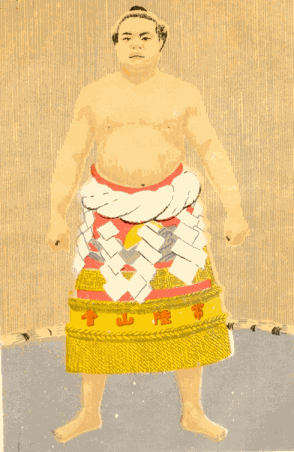 Tochigiyama,
Tochigiyama,
1918 yokozuna from Tokyo. Born 1892. 1.74 m tall, 109 kg. School: Dewa-no-umi. Loves sake, European food, and baseball
Tochigiyama lives in Tokyo-honjo, Aioi-machi. He trained under and was adopted by the old wrestler Kasugano, who now oversees a sumo tribunal under his ordinary name of Genjiro Nakata. Tochigiyama also has a "rich young wife named Ofuku."
Tochigiyama's rise was very rapid. To be sure at the beginning he had some losses, but in May 1916 he defeated Tachiyama, who was judged the best wrestler in Japan, and in the process developed a large following. The following season he was expected to defeat Tachiyama, Otori, and Isegahama. In the event he overwhelmed not only the famous Tachiyama but also Otori twice and Isegahama once. Since then his reputation has been well established; in January 1917 he became an ozeki and in January 1918 he was named the yokozuna of East Tokyo.
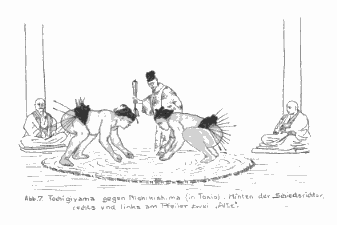 Tochigiyama
against Nishikishima (in Tokyo). Standing behind is the referee, seated
right and left at the pillars are two elders
Tochigiyama
against Nishikishima (in Tokyo). Standing behind is the referee, seated
right and left at the pillars are two eldersAfter spending four years in the humdrum elementary school, I entered the Ikuei junior high school. From this time on I grew physically larger. After getting up in the morning I would eat five or six bowls of rice with the greatest pleasure. 'If you eat so, you upset the rice prices!' I was always told. I had no preferences about what I ate, no aversions; everything was good so long as there was more.
My father's house was in a narrow lane, so we children couldn't play in the street. Therefore we always went to the nearby school yard to play; our greatest joy came during the summer, however, when we went bathing at the beach at Sakai.
In those days children rarely played sumo, and judo and swimming were what we called sports. This was for me the life, and when it was summer, I spent almost every day at the beach.
Shortly after I left the elementary school and went into the Tenoji Middle School. As I became quite strong, my father said, 'You are so strong in the middle, why don't you become a soldier?' Like all boys, I naturally had a passion for soldiers, so this corresponded entirely with my wishes, and I decided to become an officer.
Then it occurred to me that because I especially loved swimming, I should become a naval officer. At sixteen or seventeen, for example, I entered a swim meet sponsored by an Osaka newspaper. In this meet I swam five ri [19.72 kilometers] through the ocean, as pretty as you please, for which I received a first prize. At that time I was already very large, and the onlookers cried, 'He is a fatso, but he swims fine!' From sixteen years on my body was such that my parents in astonishment said, "We are both so skinny and undersized, how can the boy be so large? Maybe he has a disease." Such worries they had.
In any event at such times I kept my peace and said nothing, and was to outward appearances - also obedient, although in truth I was an obstinate pig-head.
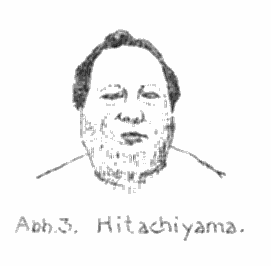 Hitachiyama
HitachiyamaTherefore I was soon done with becoming an officer. Following that decision, I decided that if I was going to accomplish anything as a wrestler I must make my own arbitrary decision and write a letter to the best wrestler in Japan at that time, Mr. Hitachiyama, in which I asked him which was the best school to attend. Soon came the reply in which he said: to become a wrestler I must have a first-class physical development and since I lived in Osaka I should report to Mr. Aioi, who was an old wrestler once known as Hanaregoma. [FN4] 'If I was found suitable, I might be accepted as a pupil.' I promptly visited Hanaregoma and upon his advice my body was very good left my school and went to Tokyo where I enrolled as a student under Hitachiyama. At the time I was nineteen years old. Now changing my mind was no longer possible, and I devoted all my strength to the instruction. By the time I was twenty-six I had achieved the highest step in wrestling knowledge, that of yokozuna. But I was with that in no way satisfied. I continued exercising not only my strength and dexterity, but on the nights before matches when I could not sleep I even went so far as to visit the Buddha at Narita to say that if my heart was impure, then to make me unable to have a good match
In questionable cases the umpire consults the Council of Elders (toshiyori). These are the four men who sit on pillows at the four poles of the arena. The audience doesn't watch just the wrestlers; they keep an especially sharp eye also on the officials, too. The reason is that they don't remove him if he has made a bad call, or if he fails to call an illegal hold or lacks dignified conduct.
The umpire wears an old-style kimono with a wide, stiff chest and shoulder parts, an old Chinese "raven-cap" (eboshi), and the war fan Gunbei-uchiwa or Kara-uchiwa, a kind of marshal's baton with which Japanese military leaders used to control their troops. As the umpire's clothing is old-fashioned his movements must be contained and the old ceremonial is accordingly dignified.
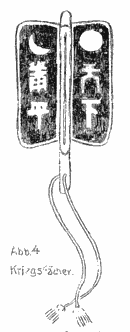 War
fans
War
fans
There are four classes of umpires. The highest class is called tate-gyoji. These men wear wooden swords in their belts, hang purple cords on their fans, and wear tabi (socks with a separate place for the big toe) and wooden sandals. Tate-gyoji are ranked with the highest wrestlers. At the moment there are only two representatives: Shonoske Kimura and Shozaburo Kimura.
The second class of umpires uses red fan cords and wears sandals without tabi. Again there are two representatives.
The third class appears barefoot in the arena, and use white-and-red fan cords. There are currently ten to twelve members.
The fourth class consists of all the umpires who officiate at the little regional contests. They have green-and-white fan cords, and enter the ring barefoot.
Three heralds appear in the ring before the wrestlers and officials. The first is the beckoner, or yobidashi. His job is to call and position the wrestlers. The second is the sword-bearer, or tachi-mochi. He carries a sword that he raises during the introductions. Finally, there is the dew-sweeper (tsuyuharai). The latter stands near the wrestlers during the introductions. These days his sole function consists of going in during the pauses between contests, after the end of rounds, etc., and "washing the rope." In other words, he wipes off the sweat and dust, splashes tea water over the chest and back, and hands out weak tea.
Other officials are involved in organizing matches between traveling teams. For example, a director is a torishimari, an advisor is a sodanyaku, an inspector is a kensayaku, and a helper is a sewagata. It should be noted that these latter officials only attend the big matches in Tokyo and Osaka, and during provincial matches laymen fulfill their responsibilities in far simpler fashion.
An excellent portrait of wrestling officials of the old days appears in the colored woodcut that faces the title page of this book. Between the four naked elders (toshiyori) one sees two ceremonial masters; in the foreground appear eight officials dressed in old-style garments and carrying weapons such as war fans and swords. All eight umpires in this picture come from the Kimura lineage. [EN17] In front of the people one notices heaps of sand stuck with bamboo staves decorated with sacrificial papers. The original woodcut, by the way, was made for a match that took place in Tokyo in 1865.
The head of the unified ring organization in the Empire holds the title oikaze, and his lineage is called "the leading house" (tsukasa-ke). According to tradition, all wrestling chiefs trace their origins back to the house of Yoshida. [EN18] The current chief is Zemmon Yoshida XXIII. He resides in Kumamoto and is sixty-four years old. In 1917 his oldest son and future successor served as a captain in the Japanese infantry at Hankau.
For contests such as take place in small towns and public schools, the sumo ring is a simple heap of sand covered with a canopy. For the professional tournaments in big cities such as Tokyo and Osaka, however, promoters have erected great halls called sumokan. Here the arena is specially prepared and very strict rules of etiquette are followed.
The Tokyo sumokan stands in the Honjo District, which is the so-called wrestling quarter located near the Ekoin Shrine. In 1657 a giant fire ravaged Edo, as Tokyo was then known, killing some 107,000 people. Afterwards a shrine was built to house the community of monks who read prayers for the souls of the dead. In time, shops and theaters sprang up throughout the area as everywhere, the profane joined with the sacred and eventually the wrestlers of Tokyo settled nearby. Around 1781 wrestling pits were erected on the wide courtyard of the Ekoin Shrine, and eventually a series of regulated wrestling tournaments were established.
Construction began on an indoor sumo arena Japan's first in May 1906. The building was called the Kokugikan, and it was completed in December 1908. When a fire destroyed this stadium in November 1917, they started work on a new iron-framed building almost immediately. Unfortunately a violent windstorm in April 1919 caused the iron roof to collapse. Several workmen were killed or injured and the damages were assessed at around ¥150,000. [EN19]
The Kokugikan hosts national tournaments twice a year. While these tournaments run from 5:00 a.m. until 5:00 p.m., the best matches take place around 9:00 a.m. Usually there is an intermission around 2:00 p.m.
In February 1918 the people of Osaka started planning a similar wrestling hall. A board of directors (muneage) was created on June 1, 1919. To commemorate the occasion, Professor Sata, the director of the local medical school, cut the hair of the assistant ring director of Osaka in a ceremonial fashion. Afterwards a priest of the Sumiyoshi Shrine dedicated the construction.
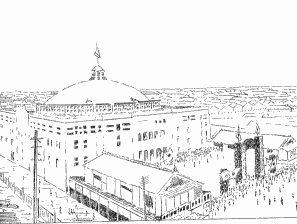 New
wrestling stadium in Osaka
New
wrestling stadium in Osaka
The locals take great pride in the 30-meter height that the wrestling
hall's drum tower is to rise above the Osaka's richest mercantile street.
The sides of the outer quadrangle of this building, by the way, are around
45 meters long. The construction cost was originally estimated at ¥200,000
but later rose to ¥500,000. The Osaka hall is designed to hold ten
thousand persons, and should be completed by early August 1919. The Osaka
medical school already possesses a second, smaller wrestling hall.
While Europeans often complain that sumo tournaments take too long, the Japanese bring their tea, tobacco, and bento boxes [EN20] and endure for hours. During these marathon events, spirited enthusiasts place bets on their favorite wrestlers, and as in a Roman circus, hotheads argue after they conclude their wagers. Enthusiasts also throw their favorite apparel into the arena. The clothing is not lost, however. Instead student wrestlers return it to the owners, naturally against a promised monetary gift.
In the Kokugikan, the wrestling arena is constructed in the middle of the hall, and the public sits in rows surrounding the arena. The arena itself is filled with sand and ringed by straw-filled sacks. Thus its name, dohyo, or "sand sack".
Four posts surround the dohyo. Each sandbag, post, and canopy has after the Japanese manner its own deep-rooted meaning; everything has its place in the cosmos.
Dohyo organization was not always so strict. Old pictures show us that wrestlers used to sit in a circle in the middle of which the two wrestlers competed. The contest site was smaller, too, maybe ten meters in diameter. In those days, the audience sat in two rows rather than all around. One row was to the east and the other was on the west. (From this practice came the customary call before the presentation: tozai, East and West.) A text called Sumo Kyujaku Rigosho reports that they began building elaborate dohyo during the Tensho Period (1573-1591). From this time on the rules regarding the construction of dohyo were strictly regulated.
Anyway, today the dohyo is outwardly four-cornered. The inside is made round by ringing it with 36 or 28 sacks. (The number of sacks that go inside the ring is apparently not strictly regulated.) The layout is designed so that one can pull out a sack from both the left and right corners, thus allowing rainwater to drain.
The ritual surrounding dohyo construction is especially rigorous whenever the Emperor is expected to attend. In the space between the four posts, for example, there must be exactly seven sandbags for a total of 28; the reason is that this corresponds with the number of heavenly constellations. And this is not the only numerological activity. For example, the fifteen sandbags of the first inside ring represent the Nine Heavens and the Six Earths. The four outside corners of the arena represent the principles of Confucianism, the inner circle those of Buddhism, and the hanging streamers (gohei) those of Shinto. Even the sand-strewn interior of the arena represents the five elements: Wood, Fire, Earth, Metal, and Water. [EN21]
During a royal tournament it used to be customary to provide sacrifices of wine and food. The oikaze came forward with these sacrifices and begged the gods of the heavens and the earth for good weather. [EN22]
Four wooden posts stand around the four outside corners of the dohyo. These poles are in turn draped and wrapped with blue, black, red, and white streamers and ornaments. As usual, there is symbolism behind all this. In the Chinese Book of Rites, blue represents the dragon (senryu), which represents spring or the east. White represents the tiger (byakko), which represents autumn or the west. Red represents the bird (shujaku), which represents summer or the south. And black represents the tortoise (gembu), which represents winter or the north.
The canopy that spans and circles and goes over the four posts is called mizuhiki, and means "water drawer". It is stretched from the north and its end reaches again to the north. Originally the canopy was black; then later it had different gay colors. These days, however, it is usually made in the imperial color, which is violet with white decorations.
The drum tower (yagura daiko) stands close by where the wrestling takes place. The drum tower is essentially a scaffolding standing 10-15 meters high. Although drum towers are traditionally made from bamboo, the one at the Kokugikan is made from iron. On wrestling days a man sits on the tower with a big drum and hits it from morning to night.
Naturally the drum tower has its own history. Formerly the Umike lineage of Ise owned the privilege of making towers, and the family rented its towers to the wrestling promoters for use during big tournaments. These days the towers' main purpose is advertising. During pageants they are pulled through the streets accompanied by flags, kettledrums, and special music; they also stand next to the wrestling area decked in advertising banners hung on long bamboo sticks.
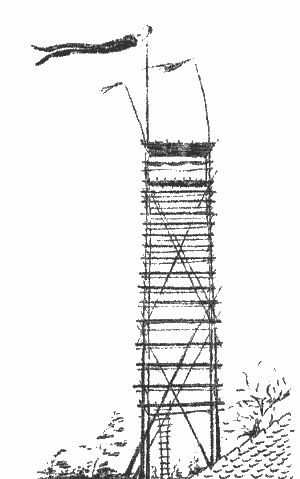 Drum
tower in Tokyo
Drum
tower in Tokyo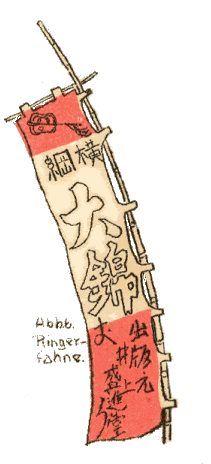 Wrestling
flag
Wrestling
flag
Assorted stretching exercises follow this ritual. Despite their well-rounded bodies the wrestlers are astonishingly agile. Leg stamping is an especially beloved exercise. While stamping their legs, the wrestlers lay their hands on their knees and quickly lift them, alternating each as high as possible to the side. To Western eyes, it is a downright comical sight. [EN25]
Upon a sign from the umpire the match begins. [EN26] The wrestlers go together in a distinctive starting position, yotsu ni kumu, that is "down on all fours." In this stance the hands are balled in fists while the spine takes as straight a line as possible, which for the Japanese with their comparatively short legs is not easily managed. The wrestlers then stare at each other for awhile. The purpose of the staring is to identify a weakness or an opening. Then suddenly with a loud shout the two wrestlers crash together. The goal is to use pushes, throws, heaving grips on the waist belt, leg movements, etc., to throw the other to the ground or out of the dohyo.
The umpire and the four elders closely observe each movement, and immediately censure any illegal technique. If one of the wrestlers is in any way thrown out of the inner ring, or if he touches the ground with any part of his body except his feet, then he loses. To stop the wrestlers, explain the situation, or pronounce his decision, the umpire uses movements of his fan.
At the big Tokyo tournaments, two-hour intermissions take place during the afternoons. During these intermissions the wrestlers make their ceremonial entrances (dohyo-iri). That is, the yokozuna appear with their heralds and the wrestlers don decorated robes and then join ranks to march into the arena. Once there, they draw up opposite the distinguished guests and then stamp their legs, clap their hands, bow, etc. [EN27]
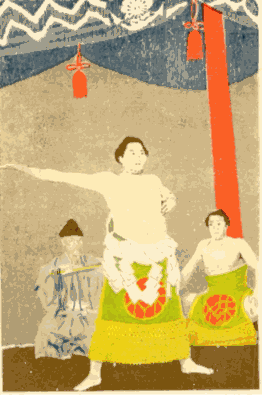 Otori,
the Phoenix 1918 Yokozuna from West Tokyo. 32 years old, 1.83 m tall, weighs
116 kg. Loves beer. To his right is Misugiiso, to his left the tournament
director. The skirts show the same school (heya).
Otori,
the Phoenix 1918 Yokozuna from West Tokyo. 32 years old, 1.83 m tall, weighs
116 kg. Loves beer. To his right is Misugiiso, to his left the tournament
director. The skirts show the same school (heya).
Sumo tournaments are advertised three main ways. Ranking sheets called banzuke (but spoken banske) provide exact programs and official ring lists, and provide the most important means of advertising.
These ranking sheets have a very definite format, and are remarkable for their thick, distinctive calligraphy. The narrow middle column carries on top the words "mo gomen," meaning "with indulgent permission," under which appear the names of the umpires, heralds, and elders. The right column posts the names of the wrestlers from the East while the left posts those from the West. The large print shows the yokozunas and ozekis. In the second cross row one finds the names of the numerous maegashiras.
Strange to say, only Japanese are initiated into reading these sheets; for Europeans they are most puzzling. While they are explained here as curiosities, the Japanese use the same format to describe other things, partly in jest and partly as a mnemonic aid. For example, a memorandum for farmers and their children listing harmful and useful insects began with the useful insects bees, for instance taking the place of the yokozuna on the west. One saw a similar arrangement in newspaper comparisons of the fleets involved in the World War. It even happens that pious Buddhists who are fans of sumo list their pious deeds in a wrestling format, using special signs to mark them. For example a great transgression is logged as "ozeki west," a little good deed as "maegashira east."
To tabulate these forms, a special commission, the banzuke hensei
yakuinkai, was established. [EN28] Although these
days one sometimes sees simpler posters with illustrations, definite marks
and abbreviations are still stipulated for writing on them. The following
table shows some of these conventions.
| Mark | Japanese Word | Translation |
| O | Kachi | Victory |
| . | Make | Defeat |
| D | Azukari | Tie |
| X | Wake | Draw |
| + | Yami | No contest |
These signs are not forced on the press and in the newspapers the signs O and .are sometimes reversed.
The second way that sumo is advertised is in the press. The Japanese press follows the ring battles, especially the big ones in the spring and summer, with lively attention. Every day brings summaries of the status of the battles complete with photos and caricatures. These caricatures are excellent, and provide in a truly striking way the appearance of the sport.
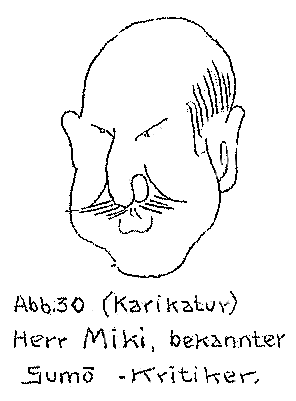 A
caricature of Mr. Miki, a famous sumo critic
A
caricature of Mr. Miki, a famous sumo criticTo give an idea of the different viewpoints the press takes when reporting about wrestling tournaments, the following are the titles of some recent articles. Subjects range from the trifling to the decreed:
"History of Sumo," (Serial 14), in Sumo Sekai, October 1915.
"Wrestlers' Forms Seen through Women's Eyes"
"Spare-time Sumo"
"Imprint of the Big Heya" (All three in Yakyukai, May 1916.)
"A Lay Wrestler" (Rakuyo) in Jinzo-Club, December 1918.
"The Heya Now and Then," in Bukyo Sekai, January 1919.
 The
old ones in danger
The
old ones in danger
Finally, sumo is advertised in technical literature. Most technical literature consists of handbooks created to provide the layman with explanations. Two of these -- "Details of the Forty-eight Holds of Sumo" by Kazura (Tokyo, 1917) and "The Forty-Eight Holds and the Most Famous Wrestlers" by Kotaro (Tokyo, 1918) were used while researching this text.
This brings us next to books that provide a little history of wrestling. For the most part, however, these simply list famous matches and their outcomes. A recent example of such a work is The Complete Wrestling Match by Yamada. An older example is called Explanation of Sumo.
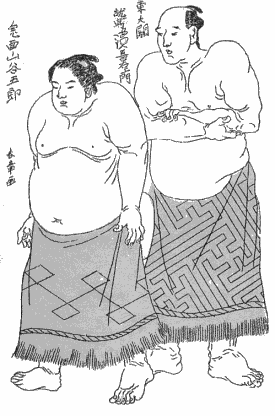 Two
wrestlers. After an old Japanese woodcut by Shunsho Katsukawa (1726-92)
Two
wrestlers. After an old Japanese woodcut by Shunsho Katsukawa (1726-92)
It is remarkable that even the old wrestling books were written with a predilection for biographies. The emphasis is first the subject, then the art. Evidently this complies with the tastes of the Japanese reading public.
In conclusion, it should suffice to say that sumo must be considered without giving aesthetic consideration to the professionals' fat, which does not afford as eye-pleasing a sight as that of the athletes in our Western colleges. In this regard, sumo's sporting value can be summarized as follows:
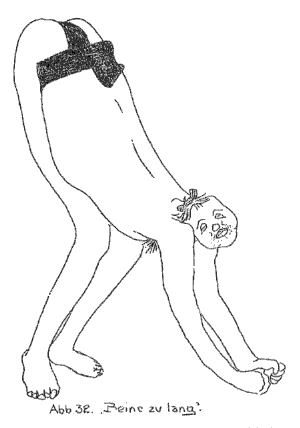 Legs
too long.
Legs
too long.This in turn leads to war veterans patronizing the sport. For example, Japanese veterans staged a tournament in the garden of Osaka's military club at the beginning of June 1919, and more one hundred affiliated clubs appeared with their banners. The guests of honor included a serving member of the royal family, Major Prince Kita-Shirakawa. The newspapers graphically described the shouts of the onlookers: "East! East!" From the opposite side came "West! West!" and "Horie Club!" And the loud, spirited cries of "Whale upsets Spring" could be heard over the roar of the crowd.
 Oh!
These divine forms!
Oh!
These divine forms!
In short, there remains much to say about sumo, its history, and especially its technical aspects. Accordingly the outpouring of literature should increase considerably over time. For the short description proposed here, however, may these words suffice.
Authors Notes
FN1. In the beginning suo were everyday clothes, but later they became festival clothes. Their wide sleeves distinguish the jackets, and the modest trailing trousers with little wooden shoes are the forerunners of hakama.
FN2. Kammuri are the caps worn by ancient Chinese officials. They are made from gauze or lacquered paper.
FN3. The parts of this costume are called oikaze, which is a silk earflap on the kammuri, and saiyo, which is a large upright bow on the kammuri. Both are marks of special authority. A gown of naturally finished silk is also worn.
FN4. Hanaregoma means "Runaway Filly," and is a typical
Japanese ring name.
Editors Notes
EN1. These were probably Boys' Day in May and the Seven-Five-Three Festival in November.
EN2. During the Tokugawa Era (ca. 1603-1868), the three chief guilds were based in Edo (the future Tokyo), Kyoto, and Osaka. Each guild sponsored one ten-day tournament per year, plus all three worked together to hold an annual national tournament. In 1911 the Kyoto guild disbanded, and in 1926 the Tokyo and Osaka guilds merged to form the Professional Japanese Sumo Association (PJSA).
EN3. Sumo training schools are fictive households. That is, the master (oyakata) is the father, the master's wife (okamisan, and the only female the trainee supposedly meets) is the mother, and the wrestlers (rikishi) are the children. The relationship is theoretically fixed: just as one cannot change parents, one is not supposed to be able to change training schools. For more on this subject, see Yoshihiro Oinuma and Mitsuru Shimpo, "The Social System of the Sumo Training School," International Review of Sport Sociology, 1:18 (1983), 6-11.
EN4. In 1992, there were 44 heya in Japan.
EN5. Although Dewanoumi started in the late eighteenth century, it only became famous after Hitachiyama, the enormously popular eighteenth yokozuna, took over as head instructor in June 1914. Its first foreign student was probably the strongman John Kentel, who trained at the club in January 1920. I don't know how long Kentel lasted, but on August 3, 1922, the Japan Times noted that the "wife of John Kentel, a Spanish pugilist, was robbed of her hand-bag, containing ¥5,200 in cash, while out for a walk with her husband A party of 200 persons gave chase and captured the alleged culprit, handing him over to the police."
EN6. The eastern camp is the more prestigious. Although the two-side system was abolished in 1930, it was reintroduced in January 1940.
EN7. Although Tittle subsequently provides literal translations, today komusubi is usually translated as "junior champion, second class." Maegashira are also ranked, but as there were at least twenty maegashira grades during the 1910s, Tittle's not listing them all is understandable.
EN8. Technically speaking, the mawashi is the canvas or silk belt while the kesho-mawashi is the decorative apron.
EN9. Depending on exchange rates, the yen was then worth about US $.47. A Japanese day laborer earned about ¥1.5 per day (Koreans and Chinese earned less), and government ministers and military officers only earned a few thousand yen per month. So an equivalent apron today would cost millions of yen or many thousands of dollars.
EN10. The practice of cutting a wrestler's hair to announce his retirement from the ring was not yet universal, and in 1937, Shinkai Sekiwake became the first champion to announce his retirement from the sumo ring by having his topknot snipped.
EN11. There were 100 sen to the yen.
EN12. The practice of taking heroic ring names, or shikona, dates to at least the 1570s.
EN13. Although Onishiki wrestled for Tokyo in 1915, he was originally from Osaka. An educated man, he took up wrestling professionally after failing to gain entrance into a military academy. Details of his early career appear in Japan Times, June 16, 1915, page 8.
EN14. While this generalization was probably true in 1919, between 1951 and 1982 six of eighteen yokozuna came from the northern island of Hokkaido. For details, see Deborah Boehm Gushman, "Sumo: The Hokkaido Connection," East-West Photo Journal, 3:8 (Spring 1982), page 42. The fathers of the well-known Japanese American sumotori and professional wrestlers Kaimon Kudo and Kinji Shibuya were also from Hokkaido.
EN15. The liking for European food was literal, and in 1914 Hilo reporters were amazed to see a visiting rikishi eat a mullet, a Spanish omelet, half a chicken, and a bowl of rice in one sitting. Due to the wrestlers' scanty attire, the American journalists didn't think the sumo matches fit for ladies, but admitted that many were in attendance.
EN16. Although Tittle neglected to provide us with a list of standard sizes, on April 21, 1909, the University of Washington Daily reported that Washington's statistical average Japanese male freshman stood 5 feet 3 inches and weighed 100.7 pounds. Obviously, one of these fellows would be lost inside a kimono measuring more than four feet from shoulder to hem.
EN17. The house of Kimura dates to 1726. Although Tittle does not say so, referees also take the name Shikimori. But, as the Shikimori house dates to 1768, Kimura referees are always senior. As with umpires, the name was (and is) professional rather than familial.
EN18. This is not exactly true, as there was also a less prestigious house of Shiga. Once again, the name was professional.
EN19. The stadium was repaired and finally completed in November 1919. Unfortunately, the Tokyo earthquake of August 1923 demolished the inside of the structure, and as a result the stadium did not reopen until May 1924. In March 1941, officials announced plans for a larger stadium, but due to the outbreak of the Pacific War in December these were never implemented. During World War II, the structure was used as a factory for manufacturing balloon bombs, and in March 1945 the building was gutted after American incendiaries ignited stored munitions. While the building was partially repaired following the war, a new larger stadium was soon built to replace it.
EN20. Small metal containers used as lunch boxes.
EN21. This geomantic configuration probably owes as much to kigaku, or popular astrology, as to classical neo-Confucianism and Buddhism.
EN22. The modern salt and water rituals probably owe something to these sacrifices.
EN23. The dohyo-iri, or purification rituals, described are attributed to two wrestlers of the 1690s named Kajinosuke Tanikaze and Kisaburo Onagawa.
EN24. Checking the participants for weapons is not as antiquarian as it may sound, for as recently as 1925, two judo men were stabbed to death following a boxing-versus-judo bout in Hokkaido.
EN25. The purpose of the leg stamping is to drive away evil spirits. Surprisingly, Tittle failed to mention equally important purification rituals involving salt and water.
EN26. As professional matches of the radio and television era rarely started so promptly, this passage may describe amateur rather than professional sumo.
EN27. Like most human traditions, dohyo-iri have changed over time. In Tittle's day, unryu was probably the most popular, as it is attributed to the yokozuna Nishinoumi II, who was champion from 1916 to 1918. That said, Tittle could have seen the shiranui, which was attributed to the champion Tachiyama. Tachiyama, by the way, was a well-traveled champion, visiting Hilo in 1914 and Shanghai in 1915.
EN28. The oldest ranking sheet of which I am aware was created for a Kyoto tournament of 1733. Ranking sheets became common after 1757.
EN29. The rest of the year, discussions centered
on the business angles of sumo, to include debating whether the matches
were fixed.